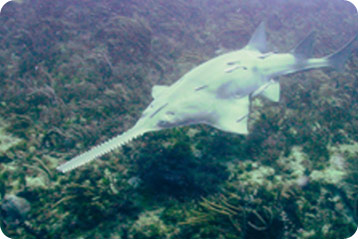It looks like something out of a cartoon -- a tool to help Popeye cut open a can of spinach, for example. But the sawfish is a real creature, and it uses its long, toothy “saw” to dig up its own meals.
 Sawfish have long snouts with teeth protruding like the teeth of a saw. Credit: Scott Cameron & Florida Museum of Natural History
Sawfish have long snouts with teeth protruding like the teeth of a saw. Credit: Scott Cameron & Florida Museum of Natural HistoryThere are actually two kinds of fish with saws. One is the sawshark. It’s a true shark, with a streamlined body and gills on its sides. A typical adult is about 3 to 5 feet long. The other is the sawfish -- a type of ray with a flattened body and gills underneath. It’s much bigger than the sawshark -- up to 20 feet or more.
Both of them stay close to shore. In fact, most sawfish are found in the murky waters of bays and estuaries, and some can even live in rivers.
Both sawfish and sawsharks have long snouts with pairs of teeth protruding from the sides like the teeth of a saw. The fish use their snouts to detect prey, to stun fish, and to dig in the mud for crabs and shrimp. They may also use them to fend off predators.
Unfortunately, though, the saws are easily snagged in fishing nets. Because of this accidental snaring, along with a loss of habitat caused by coastal development, sawfish populations have plummeted.
In the United States, sawfish used to be common from the Carolinas to the Texas-Mexico border. Today, they’re basically limited to Florida. So in 2003, the sawfish became the first marine fish to be placed on the endangered species list. But they reproduce and mature so slowly that it could take decades to begin to rebuild the population of this funny-looking fish.

